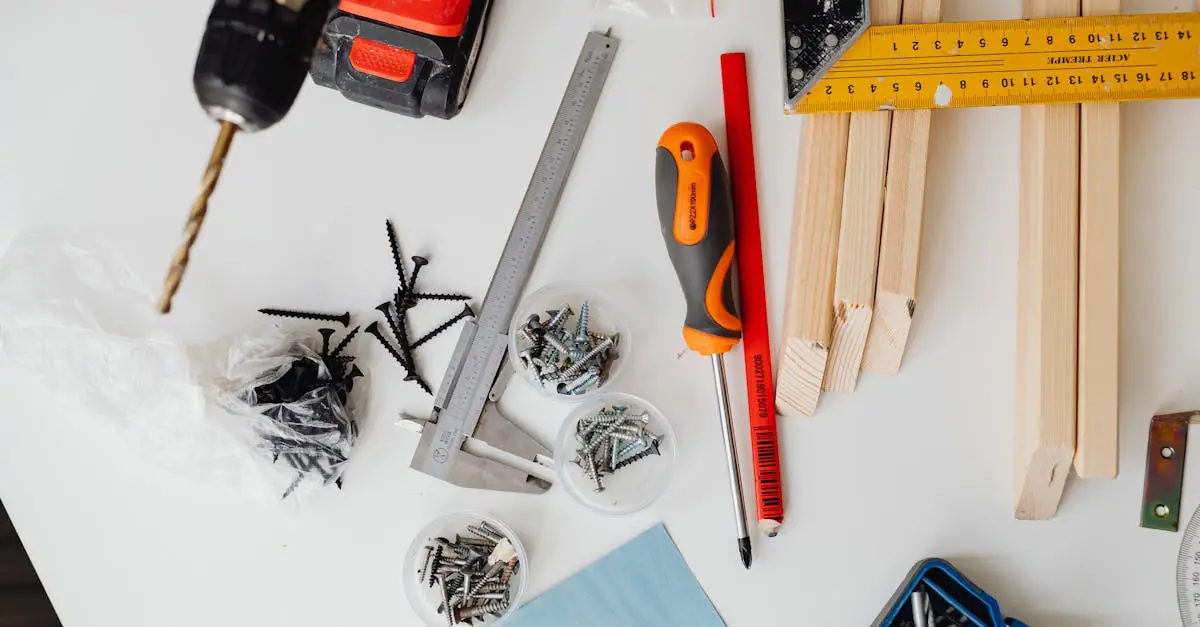In a world where store-bought solutions often break the bank, DIY engineering projects offer a thrilling escape into creativity and innovation. Imagine transforming everyday materials into something extraordinary, all while impressing your friends and maybe even your pet goldfish. Whether it’s building a robot or crafting a homemade catapult, these projects promise not just fun but also a chance to flex those engineering muscles.
But don’t worry—this isn’t just for the next Einstein or MacGyver. With a bit of guidance and a sprinkle of humor, anyone can dive into the exciting realm of DIY engineering. So grab your tools and unleash your inner inventor. Who knows? You might just create the next big thing—or at least a really cool paperweight.
Table of Contents
ToggleOverview of DIY Engineering Projects
DIY engineering projects attract many individuals looking to unleash their creativity. These projects serve as a hands-on way to transform ideas into reality.
What Are DIY Engineering Projects?
DIY engineering projects involve creating functional items or systems using available materials. Examples include building custom electronics, furniture, or simple machines. They often incorporate basic engineering principles, allowing for practical problem-solving in everyday life. Participants can design projects based on personal interests, whether robotics, woodworking, or electronics. Schools and community organizations frequently support these initiatives, fostering engagement in STEM fields.
Benefits of DIY Engineering Projects
Participating in DIY engineering projects offers numerous advantages. Enhancing critical thinking skills occurs as individuals tackle design challenges. Practical experience gained promotes a deeper understanding of engineering concepts. These projects also encourage creativity, allowing personal expression through design choices. Collaboration with others fosters teamwork and communication skills. Engaging in DIY activities can boost confidence, as completing projects creates a sense of accomplishment. Additionally, these projects often save money compared to purchasing ready-made solutions, making them accessible for a wide range of budgets.
Types of DIY Engineering Projects
Various types of DIY engineering projects cater to different skill levels. Each type offers unique challenges and rewards, encouraging creativity and problem-solving abilities.
Simple Projects for Beginners
Beginners can start with straightforward projects that require minimal materials. Examples include creating a simple catapult or a homemade flashlight. These projects help individuals learn basic engineering principles and improve hands-on skills. Each project promotes critical thinking by encouraging individuals to experiment and find solutions. Budgets remain low, making such projects approachable for many.
Intermediate Projects for Enthusiasts
Enthusiasts seeking more challenging tasks engage in intermediate projects. Building a basic robot or designing a simple bridge demonstrates application of engineering concepts. These projects often require a mix of creativity and technical skills. Collaborating on designs enhances teamwork abilities and fosters deeper understanding of materials and structures. Progressing to this level builds confidence and ignites passion for engineering.
Advanced Projects for Experts
Experts tackle advanced projects that demand high-level skills and comprehensive knowledge. Constructing drones or automating home systems showcases expertise in engineering principles. These projects involve programming and sophisticated designs, pushing the boundaries of creativity. Successful completion not only highlights individual talent but also leads to innovation. Such endeavors provide opportunities for sharing knowledge and inspiring others in the engineering community.
Essential Tools and Materials
These projects thrive with the right tools and materials. Having the essentials on hand simplifies the creative process and enhances the experience.
Basic Tools Every DIY Engineer Should Have
Essential tools form the backbone of successful DIY engineering endeavors. A versatile screwdriver set allows users to tackle various fasteners, while pliers provide the grip needed for different tasks. A reliable utility knife serves a multitude of cutting purposes, ensuring precision. Measuring tapes help in achieving accurate dimensions, making it easier to fit pieces together. Lastly, a power drill significantly speeds up the construction process, providing efficiency and convenience.
Recommended Materials for Projects
Recommended materials ensure upcycling and innovation in DIY engineering creations. Plywood offers strength and versatility, perfect for constructing structures like furniture or models. PVC pipes work well for creating frames or conduits in more complex designs. A variety of electronic components, such as resistors and LEDs, enable the development of custom circuits and devices. Moreover, strong adhesives, like epoxy or hot glue, secure components together effectively. Finally, an assortment of screws and nuts allows for lasting assembly in different projects.
Safety Tips for DIY Engineering
Engaging in DIY engineering projects requires attention to safety. Prioritizing safety not only protects individuals but also enhances overall project success.
Personal Safety Gear
Wearing personal safety gear ensures protection during projects. Safety goggles shield eyes from dust and debris. Gloves protect hands from sharp objects and chemicals. Masks filter inhaled particles and fumes, especially when working with materials like wood or paint. Ear protection dampens loud sounds from power tools, minimizing hearing damage. Always select gear appropriate for the specific task to maintain safety and effectiveness.
Safe Practices in DIY Projects
Implementing safe practices reduces accident risks. Organizing the workspace promotes efficiency and hazards’ visibility. Keeping tools in designated areas prevents tripping and clutter. Checking tools and materials for wear and damage before use ensures reliability. When using power tools, maintaining a firm grip and focusing on the task improves control. Taking breaks helps maintain focus, reducing errors and accidents while working on projects.
DIY engineering projects offer an exciting way to explore creativity while learning valuable skills. Whether someone is a beginner or an experienced maker there’s always a project that can inspire innovation and growth. By utilizing everyday materials and essential tools individuals can create functional items that not only save money but also enhance their understanding of engineering principles.
Embracing safety and organization ensures a positive experience as one dives into these projects. The journey of DIY engineering is as rewarding as the end result encouraging a spirit of invention that can lead to endless possibilities. So grab those tools and materials and start creating something extraordinary today.




